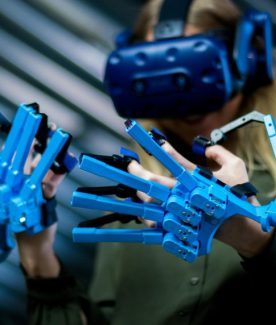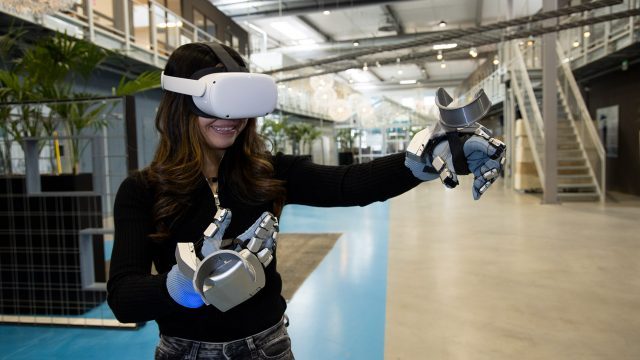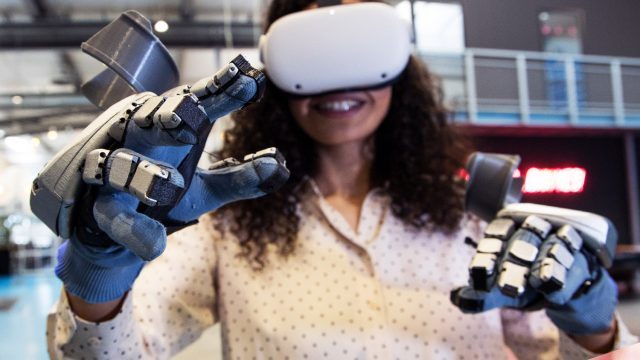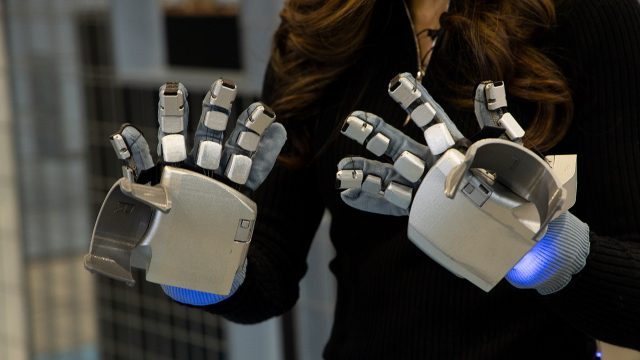SenseGlove, a Dutch-based producer of VR haptic gloves, has revealed an early prototype of their second glove, the SenseGlove Nova. We recently visited the company to see how it works and feels.
Cas and Chary VR is a YouTube channel hosted by Netherland-based duo Casandra Vuong and Chary Keijzer who have been documenting their VR journeys since 2016. They share a curated selection of their content with extra insights for the Road to VR audience.
SenseGlove’s first glove was called the DK1 and were tethered haptic gloves that use an exoskeleton attached to each finger for the force-feedback.

The first significant difference you’ll see in the SenseGlove Nova compared to the prior model is that the newer model has a futuristic design that’s much more like a glove and designed to be put on in just five seconds, according to the company. This time it’s designed for ease of use; it’s wireless and is compatible with standalone VR headsets like the Oculus Quest, Pico Neo, and Vive Focus.
The SenseGlove Nova can simulate the feeling of shapes, textures, stiffness, impact, and resistance. This is made possible with the company’s trifecta of touch: force-feedback, vibrotactile feedback, and motion tracking.
Force Feedback

The Nova uses a passive force-feedback system; instead of actively pulling the fingers back, the gloves allow you to feel virtual objects by ‘stopping’ your fingers from moving. The gloves use one magnet per finger that’s attached to pulleys and wires. Once a user grabs a virtual object, the magnets will exert power to ‘stop’ your fingers. By determining how much force it applies, you can feel the difference between hard and soft objects.
Vibrotactile Feedback

The force-feedback is enhanced by vibrotactile feedback. Both the thumb and the index finger have their own vibrotactile actuator, while an advanced voice coil actuator is located at the bottom of the glove. The voice coil actuator allows the Nova to render the feeling of realistic button clicks and impact simulations. Developers can do this by recording sound, converting it to a vibration waveform, and then bringing it inside the virtual environment to be played back by the glove.
Motion Tracking
As for motion tracking, the Nova combines sensor-based finger tracking with computer vision hand tracking algorithms. With this combination, there’s no need for external tracking devices on headsets that offer third-party access to the tracking cameras. On a more closed-off system like the Oculus Quest, the controllers are mounted on the gloves to make motion tracking possible.
During my visit, SenseGlove showed us a demo inside a zero-gravity space station where I had to do a simple repair mission. In front of me was a table with objects of different densities that I could touch and grab.

I have to note here that the Nova gloves didn’t come in the right size for my hands, so the haptic feedback wasn’t optimal. Still, like the first glove, I was able to feel the difference between, for example, a soft, squeezable ball and a battery made of glass. When I touched an object, I felt vibration. When I grabbed something, I could feel a slight resistance on my fingers, which, combined with seeing the object, made me automatically stop my fingers from moving further. It felt natural, real and I thought it was impressive, especially given the wireless freedom of movement without much latency. I did have a greater wow-factor when I demoed the DK1 as it felt more precise since the first glove had twice the strength (40 Newton instead of 20N).
SenseGlove told us that the Nova will be sold alongside the DK1 as both gloves have their pros and cons. If you’re looking for accuracy, the DK1 is a good option. The Nova is here if ease of use is more important.
The SenseGlove Nova primary use case is for commercial purposes and costs €4,500, which is about $5,300. Consumer plans are not in the works, but I think it is interesting to watch this space as it gives us a good idea of what is in store for consumers in the future.







